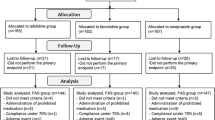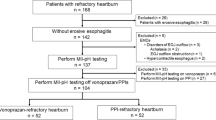Abstract
Background
To investigate whether histamine H2-receptor antagonists are sufficient to treat heartburn in nonerosive reflux disease in Japanese, who produce less gastric acid than Westerners, the efficacy of famotidine in Japanese nonerosive reflux disease patients was studied in a double-blind, placebo-controlled, parallel group-comparative, multicenter study.
Methods
The Los Angeles classification system with Japanese modifications was used to assess the severity of nonerosive reflux disease. Famotidine (10-or 20-mg doses) or placebo was administered to patients twice daily for 8 weeks. Heartburn symptoms were recorded daily by patients.
Results
A total of 528 patients participated in the study. The percentage of days without heartburn, the primary end point of the efficacy evaluation, was 62% for 40 mg and 59% for 20 mg of famotidine, and 55% for placebo, with a statistically significant difference between the 40-mg dose and placebo (P = 0.001; significance level, 0.025 one-sided). Famotidine at both doses provided immediate relief from heartburn, and relief persisted throughout the 8-week study with the 40-mg dose.
Conclusions
The results indicate that famotidine relieves heartburn symptoms in Japanese nonerosive reflux disease patients.
Similar content being viewed by others
References
Dent J, Brun J, Fendrick AM, Fennerty MB, Janssens J, Kahrilas PJ, et al. An evidence-based appraisal of reflux disease management—the Genval Workshop Report. Gut 1999;44Suppl 2:S1–S16.
Dimenas E. Methodological aspects of evaluation of quality of life in upper gastrointestinal diseases. Scand J Gastroenterol Suppl 1993;199:18–21.
Revicki DA, Wood M, Maton PN, Sorensen S. The impact of gastroesophageal reflux disease on health-related quality of life. Am J Med 1998;104:252–258.
Prasad M, Rentz AM, Revicki DA. The impact of treatment for gastro-oesophageal reflux disease on health-related quality of life. Pharmacoeconomics 2003;21:769–790.
Wiklund I, Bardhan KD, Muller-Lissner S, Bigard MA, Bianchi Porro G, Ponce J, et al. Quality of life during acute and intermittent treatment of gastro-oesophageal reflux disease with omeprazole compared with ranitidine. Results from a multicentre clinical trial. Ital J Gastroenterol Hepatol 1998;30:19–27.
Kulig M, Leodolter A, Vieth M, Schulte E, Jaspersen D, Labenz J, et al. Quality of life in relation to symptoms in patients with gastro-oesophageal reflux disease—an analysis based on the ProGERD initiative. Aliment Pharmacol Ther 2003;18:767–776.
Shi G, Bruley des Varannes S, Scarpignato C, Rhun ML, Galmiche JP. Reflux related symptoms in patients with normal oesophageal exposure to acid. Gut 1995;37:457–464.
Lundell LR, Dent J, Bennett JR, Blum AL, Armstrong D, Galmiche JP, et al. Endoscopic assessment of oesophagitis; clinical and functional correlates and further validation of the Los Angeles classification. Gut 1999;45:172–180.
Martinez SD, Malagon IB, Garewal HS, Cui H, Fass R. Non-erosive reflux disease (NERD)—acid reflux and symptom patterns. Aliment Pharmacol Ther 2003;17:537–545.
Fass R. Epidemiology and pathophysiology of symptomatic gastroesophageal reflux disease. Am J Gastroenterol 2003;98(3 Suppl):S2–S7.
Miwa H, Minoo T, Hojo M, Yaginuma R, Nagahara A, Kawabe M, et al. Oesophageal hypersensitivity in Japanese patients with non-erosive gastro-oesophageal reflux diseases. Aliment Pharmacol Ther 2004;20Suppl 1:112–117.
Kinoshita Y, Kawanami C, Kishi K, Nakata H, Seino Y, Chiba T. Helicobacter pylori independent chronological change in gastric acid secretion in the Japanese. Gut 1997;41:452–458.
Hongo M. Reflux esophagitis and Helicobacter pylori: East and West. J Gastroenterol 2004;39:909–910.
Tahir H, Sumii K, Haruma K, Tari A, Uemura N, Shimizu H, et al. A statistical evaluation on the age and sex distribution of basal serum gastrin and gastric acid secretion in subjects with or without peptic ulcer disease. Hiroshima J Med Sci 1984;33:125–130.
Feldman M, Richardson CT, Lam SK, Samloff IM. Comparison of gastric acid secretion rates and serum pepsinogen I and II concentrations in occidental and oriental duodenal ulcer patients. Gastroenterology 1988;95:630–635.
Goldschmiedt M, Barnett CC, Schwarz BE, Karnes WE, Redfern JS, Feldman M. Effect of age on gastric acid secretion and serum gastrin concentrations in healthy men and women. Gastroenterology 1991;101:977–990.
Fujiwara Y, Higuchi K, Shiba M, Yamamori K, Watanabe Y, Sasaki E, et al. Differences in clinical characteristics between patients with endoscopy-negative reflux disease and erosive esophagitis in Japan. Am J Gastroenterol 2005;100:754–758.
Fujiwara Y, Higuchi K, Watanabe Y, Shiba M, Watanabe T, Tominaga K, et al. Prevalence of gastroesophageal reflux disease and gastroesophageal reflux disease symptoms in Japan. J Gastroenterol Hepatol 2005;20:26–29.
Mishima I, Adachi K, Arima N, Amano K, Takashima T, Moritani M, et al. Prevalence of endoscopically negative and positive gastroesophageal reflux disease in the Japanese. Scand J Gastroenterol 2005;40:1005–1009.
Wada T, Sasaki M, Kataoka H, Tanida S, Itoh K, Ogasawara N, et al. Efficacy of famotidine and omeprazole in healing symptoms of non-erosive gastro-oesophageal reflux disease: randomizedcontrolled study of gastro-oesophageal reflux disease. Aliment Pharmacol Ther 2005;21:2–9.
Arnestad JS, Kleveland PM, Waldum HL. In single doses ranitidine effervescent is more effective than lansoprazole in decreasing gastric acidity. Aliment Pharmacol Ther 1997;11:355–358.
Hedenstrom H, Alm C, Kraft M, Grahnen A. Intragastric pH after oral administration of single doses of ranitidine effervescent tablets, omeprazole capsules and famotidine fast-dissolving tablets to fasting healthy volunteers. Aliment Pharmacol Ther 1997;11:1137–1141.
Khoury RM, Katz PO, Castell DO. Post-prandial ranitidine is superior to post-prandial omeprazole in control of gastric acidity in healthy volunteers. Aliment Pharmacol Ther 1999;13:1211–1214.
Bytzer P. Goals of therapy and guidelines for treatment success in symptomatic gastroesophageal reflux disease patients. Am J Gastroenterol 2003;98(3 Suppl):S31–S39.
Donnellan C, Sharma N, Preston C, Moayyedi P. Medical treatments for the maintenance therapy of reflux oesophagitis and endoscopic negative reflux disease. Cochrane Database Syst Rev 2005;2:CD003245.
Joh T, Miwa H, Higuchi K, Shimatani T, Manabe N, Adachi K, et al. Validity of endoscopic classification of nonerosive reflux disease. J Gastroenterol 2007;42:444–449.
Miwa H, Sasaki M, Furuta T, Koike T, Habu Y, Ito M, et al. Efficacy of rabeprazole on heartburn symptom resolution in patients with non-erosive and erosive gastro-oesophageal reflux disease: a multicenter study from Japan. Aliment Pharmacol Ther 2007;26:69–77.
Ebi O. Implementation of new Japanese GCP and the quality of clinical trials—from the standpoint of the pharmaceutical industry (in Japanese with English abstract). Gan To Kagaku Ryoho (Jpn J Cancer Chemother) 1997;24:1883–1891.
Hoshihara Y. Endoscopic findings of GERD (in Japanese with English abstract). Nippon Rinsho (Jpn J Clin Med) 2004;62:1459–1464.
Nakamura T, Shirakawa K, Masuyama H, Sugaya H, Hiraishi H, Terano A. Minimal change oesophagitis: a disease with characteristic differences to erosive oesophagitis. Aliment Pharmacol Ther 2005;21:19–26.
Hongo M. Minimal changes in reflux esophagitis: red ones and white ones. J Gastroenterol 2006;41:95–99.
van Pinxteren B, Numans ME, Bonis PA, Lau J. Short-term treatment with proton pump inhibitors, H2-receptor antagonists and prokinetics for gastro-oesophageal reflux disease-like symptoms and endoscopy negative reflux disease. Cochrane Database Syst Rev 2006;3:CD002095.
Richter JE, Kovacs TOG, Greski-Rose PA, Huang B, Fisher R. Lansoprazole in the treatment of heartburn in patients without erosive oesophagitis. Aliment Pharmacol Ther 1999;13:795–804.
Wolfe MM, Sachs G. Acid suppression: optimizing therapy for gastroduodenal ulcer healing, gastroesophageal reflux disease, and stress-related erosive syndrome. Gastroenterology 2000;118(2 Suppl 1):S9–S31.
Lind T, Cederberg C, Ekenved G, Haglund U, Olbe L. Effect of omeprazole—a gastric proton pump inhibitor—on pentagastrin stimulated acid secretion in man. Gut 1983;24:270–276.
Cederberg C, Ekenved G, Lind T, Olbe L. Acid inhibitory characteristics of omeprazole in man. Scand J Gastroenterol 1985;20Suppl 108:105–112.
Author information
Authors and Affiliations
Rights and permissions
About this article
Cite this article
Hongo, M., Kinoshita, Y. & Haruma, K. A randomized, double-blind, placebo-controlled clinical study of the histamine H2-receptor antagonist famotidine in Japanese patients with nonerosive reflux disease. J Gastroenterol 43, 448–456 (2008). https://doi.org/10.1007/s00535-008-2186-5
Received:
Accepted:
Published:
Issue Date:
DOI: https://doi.org/10.1007/s00535-008-2186-5




